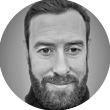
Full disclosure: I am not an ophthalmologist. In fact, if I am ever found waving a sharp instrument anywhere near someone’s eyes, then something has gone very wrong for both of us.
My journey to becoming a contributor to CRST Europe began in the unlikely place of digital innovation for consumer tech companies such as Microsoft, Samsung, and Sony. After I took a conscious sidestep into the pharmaceutical and life sciences industries, a chance engagement with venture capital brought me into the fascinating area of eye care.
I mention my personal journey only to establish my credentials as an industry outsider and to underscore my lack of credibility on anything remotely medical. I am not a doctor or even a specialist in vision technology. I am, however, lucky to know some people who are, so I will leave it to Arthur B. Cummings, MB ChB, FCS(SA), MMed(Ophth), FRCS(Edin); Ranya Habash, MD; and Michael Mrochen, PhD (see the sidebars), to provide qualification on each of the topics in this article.
Transformation
Digital, disruption, and data—the three Ds of transformation—are everywhere these days. They are the headline subject of conferences, and everybody knows of someone involved in something devastatingly disruptive and data-driven in the digital space. With all this talk, the three Ds have developed a quasi-magical quality. They can appear like binary things that happen to industries, driven by people with arcane knowledge (and venture capital backing), rather than a series of progressive and positive developments in which industry practitioners can (and should) play an active role.
Here is a bit of editorial sage burning to dispel some of that magic.

Arthur B. Cummings, MB ChB, FCS(SA), MMED(OPHTH), FRCS(Edin)
Duncan’s take is spot-on when it comes to the importance of demystifying digital technology and empowering ophthalmologists to be a guiding force in the transformation of the field. The responsibility for driving this change, however, shouldn’t rest solely on the shoulders of the clinicians, who are already being asked to do more with less. Health care systems and academic institutions should be supporting this transformation by increasing the focus on digital innovation within continuing medical education for individual practitioners, supporting technology pilot programs within individual institutions, and advocating for the introduction of standards in digital care across the eye health field.
Digital. Digital has become shorthand for anything to do with computers and the internet. So, ask yourself what the future of eye care should look like if all ophthalmologists are using tools connected to a network and all patients are carrying around pocket supercomputers, equipped with ultra–high-definition cameras and connected to that same network. Exciting, right? You are now thinking like a digital strategist.
Disruption. Disruption means finding cheaper ways to do something using technology. According to the late, great Clayton Christensen, developer of the theory of disruptive innovation, it starts with new ways to do the high-volume, low-value things no one is interested in doing and slowly works up to the big, sexy stuff.1 Watch out for it and get involved. Unless you are a monopolist or terminally set in your ways, it tends to be a good thing.
Data. Data refers to the process of collecting information and storing that information in a way that it can be used. A really big spreadsheet is still just a spreadsheet—don’t let anyone convince you that it is anything more.
In a medical field such as ophthalmology, getting practitioners actively involved in innovation is about more than just a sense of participation and an equitable share of the benefits. Health care is a space in which fake-it-till-you-make-it approaches can have dire consequences. The spectacular fall of the blood diagnostics company Theranos has aptly demonstrated what happens when tech ambition outstrips medical knowledge, scientific rigor, and ethical governance.

Ranya Habash, MD
Keep. It. Simple. is the first concept many of us learn in medical school, and it rings true throughout our careers. The same concept applies to digital health. Thanks to big tech, we carry a host of digital health tools in our pockets. Using the native features on any smartphone, we can effectively screen, diagnose, and treat a wealth of eye conditions. For example, at Bascom Palmer Eye Institute, we routinely teletriage patients before they come to the ER, and we perform complex second-opinion virtual consultations around the world, all with a simple video call to the patient’s device. This practice has become a game-changer for health care and for eye care specifically. It enables us to save patients the time, expense, and worry of an ER visit and bring them tertiary-level care from specialists whom they would not typically have had the chance to see. We’re screening, diagnosing, and treating potentially blinding—and even life-threatening—conditions with an act that every teenager does without thinking: snapping a simple selfie.
The Walls Come Tumbling Down
Now that I’ve attempted to light the fire of a physician-driven digital revolution, I’m going to pour a little cold water on that smoking tinder. Digital innovation has been slow to take hold in eye care because there are significant barriers within the existing system.
A small, innovative team may be able to develop a digital health solution that works within a single clinical setting, but it is difficult to scale any solution in eye care. It normally requires significant alteration to make the same digital product work with the systems of a neighboring hospital or clinic. Regulatory approval compounds the issue because it is set up for traditional medical devices that typically just need to be plugged into the wall. This also limits the availability of capital to fund innovation because venture investors value scalability and speed of adoption above all else.
The entire global population is walking around with small network-connected supercomputers in their pockets. We cannot, however, put all of that technology to good use in improving eye health. But, help is at hand in the form of big tech. Apple, Google, Microsoft, and Amazon have well-publicized interests in the health care industry. Platforms such as Apple Health Records will create a foundational infrastructure that allows individual innovators to build devices and applications on platforms already integrated into the health care system. This will effectively be the App Store for medical devices.
We are at least 2 years away from any of the tech giants’ providing a viable route to market because the platforms themselves will have to be approved and integrated after clearing new regulations and regulatory approval pathways. But, once they are established, it will be infinitely easier to bring new digital health solutions into the clinical setting, creating new treatment options for clinicians and improving patient outcomes.
They say everyone has one book in them. Well, I say that every ophthalmic surgeon has at least one digital eye health solution in them. Get ready for an explosion in innovation—or, as Michael Mrochen, PhD, wrote in CRST Europe’s June 2019 issue, a “tsunami of digital disruption.”2 (To read Professor Mrochen’s article, click here.)
No Digital Magic Bullets
Long-term patient care is often handled by large clinical teams comprising multiple specialties. Patients move between institutions over time, often shifting between state-provisioned and private or self-funded models. Many patients develop eye problems long before they are identified and are often referred by general practitioners and specialists in other fields. The patient experience also differs significantly from country to country, depending on who pays and how the system is regulated.
Eye health is a complex space. An ophthalmic surgeon isn’t a taxi driver, and the patient’s eye care journey isn’t a 15-minute ride to the station. The solution is not going to be the Uber for eye health.

Michael Mrochen, PhD
Today, eye health is still focused on sick care, whereas other medical disciplines have moved on to digital health care or even to wellness and lifestyle management. A good example is the evolution of the dental industry. Thirty years ago, people visited the dentist only when they were experiencing pain. Today, many consider regular dental visits to be part of a healthy lifestyle, essential to maintaining their smiles and looking after their teeth.
Going beyond sick care in ophthalmology requires alignment among all stakeholders to deliver vision at new points of care and enable patients to enjoy better vision and well-being while also reducing the burden on health care systems. Alignment must go beyond patients, ophthalmologists, manufacturers, and payers. Tackling the global burden of vision care will require alignment with governments and leaders around the globe.
Where do we begin? We should start with people who are willing to collaborate beyond our industry. This will allow us to translate digital solutions into ophthalmology, bringing with it significant funding that will attract talent from different innovative areas.
The Lancet Global Health Commission on Global Eye Health: Vision Beyond 2020 identified eye health as being critical to sustainable development goals around the world, including reducing poverty and improving productivity, education, and equity.3 It also estimated that there was US$410.7 billion of lost economic productivity due to visual impairment in 2020. However, between 1990 and 2020, the age-standardized prevalence of blindness fell by 28.5%. The Lancet Commission identified the size and availability of the workforce as a key limiting factor in achieving further significant reductions in preventable blindness.
There is no one-size-fits-all digital solution to a problem this complex. How can digital technology be combined with the knowledge and expertise of the ophthalmic community to deliver solutions at a scale and price that can help end preventable blindness and improve eye health worldwide?
One way or another, digital disruption is coming to the world of eye health. With the help of ophthalmologists, it can be a positive force that expands the reach of the knowledge and expertise of the community to positively affect the eyes and lives of many people globally. Dr. Cummings highlighted what is at stake in his editorial: “Uncorrected refractive error and cataract make up 75% to 90% of the global burden of visual impairment, depending on the reference.”
The collaborative mindset highlighted by Professor Mrochen will be a key ingredient in this journey, pooling the knowledge within the community and bringing in outside expertise to enable new solutions. The Keep. It. Simple. mantra offered by Dr. Habash is an essential reminder that, just because digital health feels new or unfamiliar, it is not any more difficult to implement than new technology coming from more traditional industry sources.
See you in the future.
1. Bower JL, Christensen CM. Disruptive technologies: catching the wave. Harvard Business Review. 1995. Accessed September 24, 2021. https://hbr.org/1995/01/disruptive-technologies-catching-the-wave
2. Mrochen M. Ride the tsunami of digital disruption. Cataract & Refractive Surgery Today Europe. 2019;14(6):30-33. https://crstodayeurope.com/articles/2019-june/ride-the-tsunami-of-digital-disruption
3. Burton MJ, Ramke J, Marques AP, et al. The Lancet Global Health Commission on Global Eye Health: vision beyond 2020. Lancet Glob Health. 2021;9(4).


